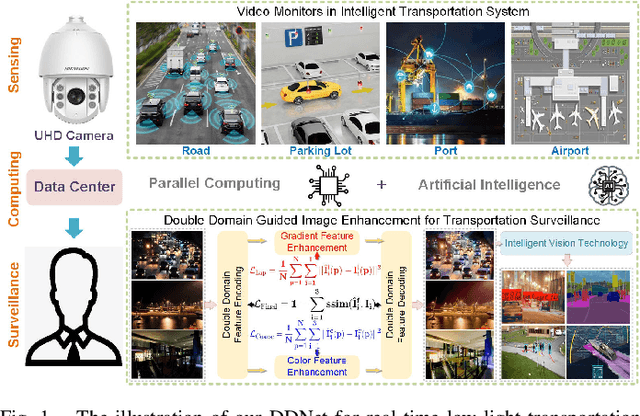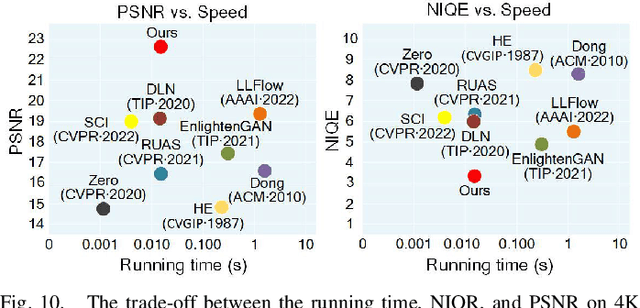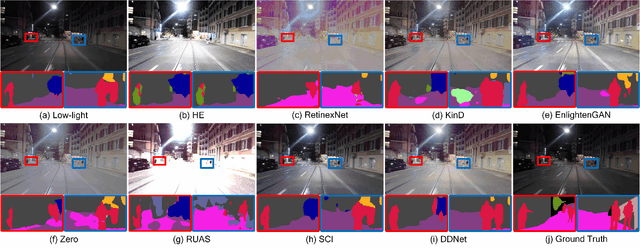Fei-yue Wang
Double Domain Guided Real-Time Low-Light Image Enhancement for Ultra-High-Definition Transportation Surveillance
Sep 15, 2023



Abstract:Real-time transportation surveillance is an essential part of the intelligent transportation system (ITS). However, images captured under low-light conditions often suffer the poor visibility with types of degradation, such as noise interference and vague edge features, etc. With the development of imaging devices, the quality of the visual surveillance data is continually increasing, like 2K and 4K, which has more strict requirements on the efficiency of image processing. To satisfy the requirements on both enhancement quality and computational speed, this paper proposes a double domain guided real-time low-light image enhancement network (DDNet) for ultra-high-definition (UHD) transportation surveillance. Specifically, we design an encoder-decoder structure as the main architecture of the learning network. In particular, the enhancement processing is divided into two subtasks (i.e., color enhancement and gradient enhancement) via the proposed coarse enhancement module (CEM) and LoG-based gradient enhancement module (GEM), which are embedded in the encoder-decoder structure. It enables the network to enhance the color and edge features simultaneously. Through the decomposition and reconstruction on both color and gradient domains, our DDNet can restore the detailed feature information concealed by the darkness with better visual quality and efficiency. The evaluation experiments on standard and transportation-related datasets demonstrate that our DDNet provides superior enhancement quality and efficiency compared with the state-of-the-art methods. Besides, the object detection and scene segmentation experiments indicate the practical benefits for higher-level image analysis under low-light environments in ITS.
Mutual Clustering on Comparative Texts via Heterogeneous Information Networks
Mar 09, 2019



Abstract:Currently, many intelligence systems contain the texts from multi-sources, e.g., bulletin board system (BBS) posts, tweets and news. These texts can be ``comparative'' since they may be semantically correlated and thus provide us with different perspectives toward the same topics or events. To better organize the multi-sourced texts and obtain more comprehensive knowledge, we propose to study the novel problem of Mutual Clustering on Comparative Texts (MCCT), which aims to cluster the comparative texts simultaneously and collaboratively. The MCCT problem is difficult to address because 1) comparative texts usually present different data formats and structures and thus they are hard to organize, and 2) there lacks an effective method to connect the semantically correlated comparative texts to facilitate clustering them in an unified way. To this aim, in this paper we propose a Heterogeneous Information Network-based Text clustering framework HINT. HINT first models multi-sourced texts (e.g. news and tweets) as heterogeneous information networks by introducing the shared ``anchor texts'' to connect the comparative texts. Next, two similarity matrices based on HINT as well as a transition matrix for cross-text-source knowledge transfer are constructed. Comparative texts clustering are then conducted by utilizing the constructed matrices. Finally, a mutual clustering algorithm is also proposed to further unify the separate clustering results of the comparative texts by introducing a clustering consistency constraint. We conduct extensive experimental on three tweets-news datasets, and the results demonstrate the effectiveness and robustness of the proposed method in addressing the MCCT problem.
 Add to Chrome
Add to Chrome Add to Firefox
Add to Firefox Add to Edge
Add to Edge